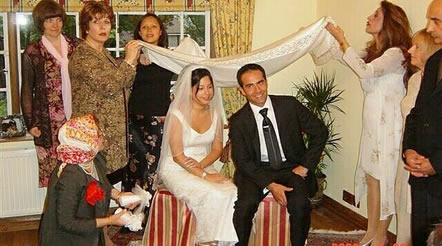
|
| Iranian
Wedding Culture and Traditions Traditionally Sofreh-ye Aghd is set on the floor facing east, the direction of sunrise (light). Consequently when bride and bridegroom are seated at the head of Sofreh-ye Aghd they will be facing "The Light". By custom Aghd would normally take place at bride's parents/guardians home. The arrival of the guests, who are to be witnesses to the marriage of the couple, initiates the wedding ceremony. Traditionally the couples' guardians and other elder close family members are present in the room to greet the guests and guide them to their seats. After all the guests are seated the bridegroom is the first to take his seat in the room at the head of Sofreh-ye Aghd. The bride comes afterwards and joins the bridegroom at the head of Sofreh-ye Aghd. The bridegroom always sits on the right hand side of the bride. In Zoroastrian culture the right side designates a place of respect. Persian Wedding Spread - Persian Wedding Sofreh Aghd The spread that is used on the floor as the backdrop for Sofreh-ye Aghd was traditionally passed from mother to daughter (or occasionally son). The spread is made of a luxurious fabric such as "Termeh" (Cashmere: A rich gold embroidered fabric originally made in Cashmere from the soft wool found beneath the hair of the goats of Cashmere, Tibet, and the Himalayas), "Atlas" (Gold embroidered satin) or "Abrisham" (Silk). On Sofreh-ye Aghd, the following items are placed: Mirror (of fate) "Aayeneh-ye Bakht" and two Candelabras (representing the bride and groom and brightness in their future) one on either side of the mirror. The mirror and two candelabras are symbols of light and fire, two very important elements in the Zoroastrian culture. When the bride enters the room she has her veil covering her face. Once the bride sits beside the bridegroom she removes her veil and the first thing that the bridegroom sees in the mirror should be the reflection of his wife-to-be. A tray of seven multi-colored herbs and spices "Sini-ye Aatel-O-Baatel" to guard the couple and their lives together against the evil eye, witchcraft and to drive away evil spirits. This tray consists of seven elements in seven colors: Poppy Seeds "Khash-Khaash"
(to break spells and witchcraft), Wild Rice "Berenj"
Angelica "Sabzi Khoshk ", Salt
"Namak" (to blind the evil eye), Nigella Seeds
"Raziyaneh", Black Tea "Chaay",
Frankincense "Kondor" (to burn the evil
spirits)
|
